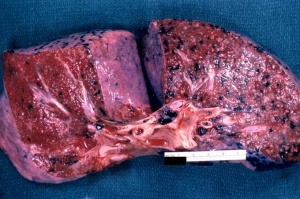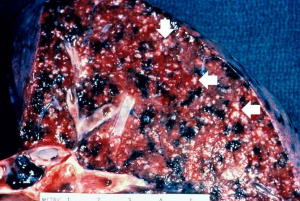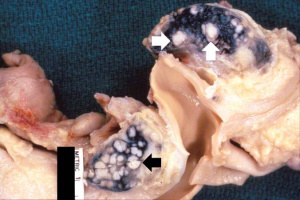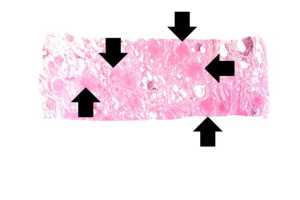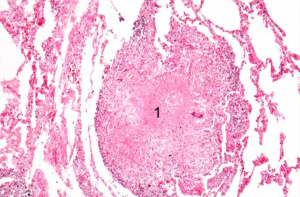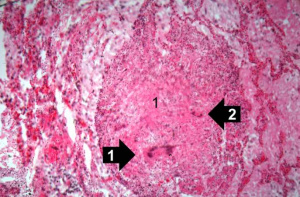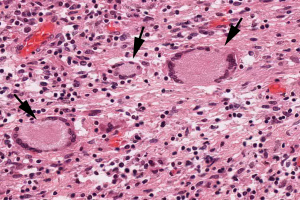IPLab:Lab 1:Tuberculosis
Contents
Clinical Summary[edit]
This 70-year-old man was admitted to the hospital with a history of upper abdominal pain, anorexia, nausea, and general malaise, all of approximately three weeks' duration. His hospital stay was characterized by fever and severe respiratory distress. There were multiple densities in the patient's chest x-ray consistent with pneumonia and examination of a stained sputum specimen showed acid fast bacilli. Despite intensive therapy, the patient progressively deteriorated and died 14 days after admission.
Autopsy Findings[edit]
It was determined at autopsy that the patient suffered from pulmonary tuberculosis with widespread dissemination throughout the body. The left lung weighed 620 grams and the right lung 1230 grams. These were characterized by marked congestion and edema. In addition, multiple gray-white nodules ranging from pinpoint size up to 1 cm were diffusely distributed throughout the lung parenchyma.
Images[edit]
Study Questions[edit]
Additional Resources[edit]
Reference[edit]
- eMedicine Medical Library: Tuberculosis
- Merck Manual: Tuberculosis
- Centers for Disease Control: Tuberculosis
Journal Articles[edit]
- Lee MP, Chan JW, Ng KK, Li PC. Clinical manifestations of tuberculosis in HIV-infected patients. Respirology 2000 Dec;5(4):423-6.
Images[edit]
| |||||
In alcoholics, aspiration pneumonia is common--bacteria enter the lung via aspiration of gastric contents.
Acid fast bacilli are not easily decolorized by acid during staining. This is characteristic of mycobacteria.
A normal left lung weighs 375 grams (range: 325 to 480 grams).
A normal right lung weighs 450 grams (range: 360 to 570 grams.
Disseminated tuberculosis refers to the hematogenous spread of tuberculous lesions throughout the body. It is also known as miliary tuberculosis (which is so-called because the lesions resemble millet).
A tuberculosis granuloma is a focus of granulomatous inflammation caused by CHRONIC tuberculosis infection. The granuloma consists of epithelioid cells (activated macrophages) surrounded by lymphocytes, plasma cells, and fibroblasts.
Anthracotic pigment is coal dust deposited in the lungs--it is seen in coal miners, city-dwellers, and smokers.
Disseminated tuberculosis refers to the hematogenous spread of tuberculous lesions throughout the body. It is also known as miliary tuberculosis (which is so-called because the lesions resemble millet).
Caseous means cheesy.
